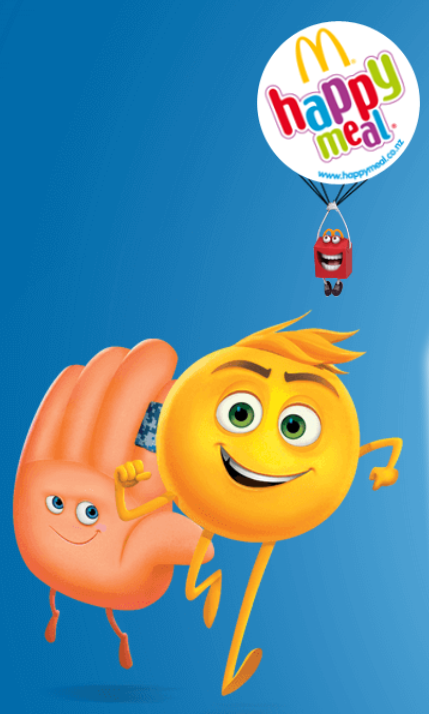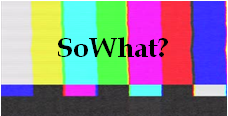Food for Thought: The Emoji Movie Happy Meal
Normally we hear narratives about the sexism attributed to the distribution of Happy Meal toys or the links between fast food and obesity. While these are both really important topics, this article isn't about either of them.

image source: https://www.happymeal.co.nz/#/index
The current McDonald’s promotion gives children a plush character toy from The Emoji Movie with their Happy Meal.
Fun Fact: The toys are considered ‘gender neutral’ so customers aren’t asked if the meal is for a boy or a girl and therefore require a toy aligned with the child’s gender (which is standard procedure). So that’s a win!
Making Connections
There is, however, an odd connection between the McDonald’s Happy Meal and The Emoji Movie.
THE HAPPY MEAL, broadly speaking, is targeted to children 7 years and under. Although there is no age restriction or guideline to support this.
THE EMOJI MOVIE centers on the world of emojis with all of the characters representing a different emoji. An emoji is a graphic symbol most commonly used as a form of communication in phone messaging services, typically on Apple iPhone and Android platforms. The Movie is also rated PG with a customer note stating that “Some scenes may scare very young children” (Footnote 1). The official classification for a PG label says that, “It is important to remember that PG films can be aimed at an adult audience and to be aware of the content of a film if you are taking children to it” (Footnote 2)

Does it really matter that young children are given a toy for a movie that they probably haven't and won't see, that is about emojis which they also probably don't know about or use?
Young children will typically interpret the Happy Meal toy as a gift or a kind gesture, not for what it actually is - a form of advertising. Children are receiving film merchandise with their Happy Meal. What's more, the marketing strategy of giving out film merchandise with a children's meal still achieves the purpose of promoting the film regardless of whether the child has seen or even heard of the movie before.
CHILDREN DON'T JUST GET A TOY WITH THEIR HAPPY MEAL, THEY GET AN ADVERTISEMENT
Once the Happy Meal has been eaten the child is left with the toy (a piece of advertising).
The child plays with the toy for a while. It breaks, or they get bored with it, and then the toy is gone.
But what stays with the child is a connection between the image of the toy and the “Happy” feeling of the McDonald's experience.
When the child then sees other images related to The Emoji Movie it triggers the “Happy” connection established with the Happy Meal experience and that "Happy" connection is reestablished with the next image.
These secondary images could be film trailers, movie posters, other merchandise - clothing, lunchboxes etc. McDonald's even produces secondary images to support the promotion. In this case, the McDonald's website includes The Emoji Movie trailer and a printable activity sheet.
WITH THE HAPPY MEAL TOY, THE EMOJI MOVIE IS ABLE TO INCREASE ITS FAN BASE WITHOUT CHILDREN EVEN SEEING THE FILM!
Here Are Some Healthier Takeaway Moments:
First, knowledge is power. By understanding how the media works we can take back the power in our relationship with it. By understanding that the toy is a form of advertising we can alter our experience with it.
Second, we can choose to decrease (or increase) the meaning and value of the Happy Meal Toy (the advertisement).
Here are some suggestions to limit the power and meaning children give to the toy:
- Instead of getting excited with the child about the surprise of a new toy, try and focus on other aspects of the experience - the food, the time shared with the family etc.
- Instead of encouraging the child to collect all of the toys in the set, remind them that they might get another one in the set next time, or a completely different toy, and that's fine too.
- Instead of making the toy a valued item, ask the child if they want to take it home or leave it at McDonald's for someone else to enjoy.
- Instead of holding the toy to a different standard then other toys, put it in a toy box at home with miscellaneous toys or in a toy box with similar toys so it becomes just another soft toy, or just another car.
- Instead of choosing the Happy Meal because the child wants a toy, remind the child that they are going to McDonald's to eat a meal not to get a new toy.
- Instead of highlighting the connections between the toy and what it is advertises, talk about it in terms of what it literally is – a monkey, a smiley face, etc
Footnote 1: https://www.hoyts.co.nz/movies/2017/the_emoji_movie.aspx
Footnote 2: https://www.classificationoffice.govt.nz/find-ratings/new-zealands-classification-labels/
THIS ARTICLE IS AN ORIGINAL CONTRIBUTION
Author: Melissa Gould, Ph.D (AUT), MCS, BCS (Hons), BCS.
Dr Melissa Gould holds a Ph.D from the School of Communications at Auckland University of Technology in Auckland, New Zealand. She worked as a Media and Communications Lecturer at the School, and now works as an independent researcher and writer. Her primary research areas include media communication theory and cultural studies that examine religion, gender, religion, and childhood.
If you would like to read similar articles from this author, or if there is a topic you would like me to discuss you can contact and follow me:
website: http://www.sowhat.co.nz/
facebook: https://www.facebook.com/QuestionSoWhat/